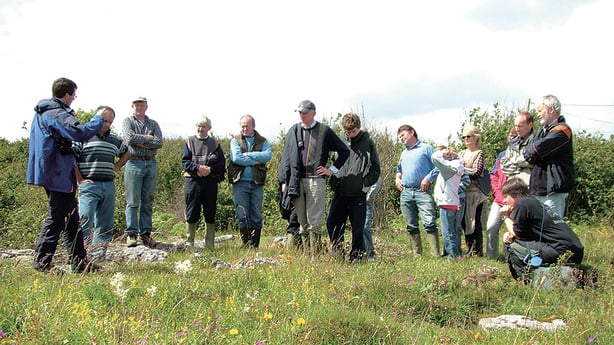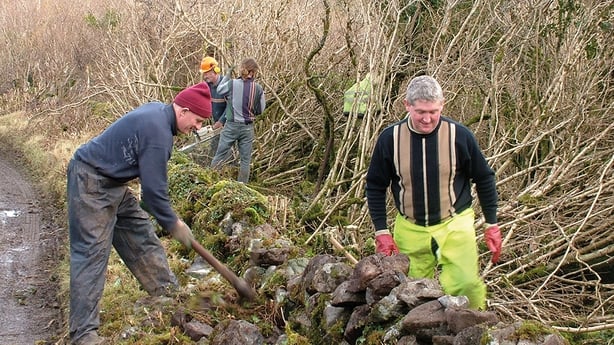Analysis: The BurrenLIFE project developed a blueprint for sustainable farming to meet the needs of both farmers and the environment
This article is now available above as a Brainstorm podcast. You can subscribe to the Brainstorm podcast through Apple Podcasts, Stitcher, Spotify or wherever you get your podcasts.
By Anne Kinsella, Teagasc
The Burren is famous for its exposed limestone landscape which contains a range of geological features, including some of the best limestone pavements anywhere in the world and species-rich grasslands. Renowned for its monuments and its remarkable legacy in stone tracing the evolution of farming, this rocky outpost in Co Clare is most celebrated for its flora and fauna, with three-quarters of all of Ireland's native flowers found here. Most of the region is protected as a Special Area of Conservation.
The BurrenLIFE project developed a new model for the sustainable agricultural management of the priority habitats of the region. It did this by developing an evidence-based approach to managing species-rich grasslands, other limestone habitats and water quality as part of livestock systems. In 2010, it was selected as one of the "Best of the Best" nature projects from the LIFE Programme.

The project was instrumental in informing the development of existing and future agri-environmental policy and schemes and became a template for the advancement of future research. The European Commission's Directorate-General for Agriculture and Rural Development used the project as an example to guide future European Innovation Partnerships.
Farming in the Burren
Farming plays a vital role in maintaining the Burren, but reduced farming activity in recent decades led to the slow degradation of priority habitats through under-grazing, abandonment and the loss of land management traditions.
For thousands of years, out-wintering has been practised in the Burren, with the seasonal movement of livestock between summer and winter pastures. From mid-October onwards, farmers herd their cattle up onto the Burren winterages where the heat absorbed from the summer sun by the limestone is slowly released in the winter, resulting in a dry warm place for livestock to lie. In 2019, this tradition of 'Winterage in the Burren' was added to a UNESCO inventory of Intangible Cultural Heritage celebrating living cultural heritage practices in Ireland.
We need your consent to load this rte-player contentWe use rte-player to manage extra content that can set cookies on your device and collect data about your activity. Please review their details and accept them to load the content.Manage Preferences
From RTÉ News, farmers send cows out to 'winterage' in the Burren
'Back to basics'
One of the key factors for the success of the BurrenLIFE project was the support from the local farming community, including the Burren Irish Farmers' Association.Teagasc's technical expertise was also used, including investigating new systems of supplementary feeding, targeted grazing and water provision to conserve the Burren’s rich heritage.
This ‘back to basics’ ground up approach was implemented on a select number of BurrenLIFE monitor farms, with a LIFE plan compiled to cater for each farm’s unique situation. The expansive and diverse landscape cannot be managed in isolation from the farmers and through the project it was of utmost importance to celebrate and support this.
One of the objectives of the project was to develop a blueprint for sustainable farming to meet the needs of the environment and that of the farmers who manage it. Doing this involved implementing such practices as new feeding systems, redeployment of existing livestock and targeted scrub removal; developing new support mechanisms for the sustainable management of the Burren habitats through research and advisory services; marketing initiatives; co-operative structures and a review of existing agri-environmental schemes. The project also enhanced awareness and skills relating to the heritage and its management.

What happened next?
After the BurrenLIFE project, a pioneering a farmer-led scheme was put in motion, which incorporated a ‘result-based’ approach to payments for the first time in Ireland. As a direct consequence, the Burren Farming for Conservation Programme was launched by the Department of Agriculture, Food and the Marine in 2010, providing payments to farmers of about €1 million per year.
By 2013, over 14,500 ha were covered by the Farming for Conservation Programme, covering 46% of the Burren's Special Area of Conservation. By 2022 this had increased to 23,000 ha or over 70% of the area. This work directly informed the expansion of targeted output-based agri-environmental projects in the Rural Development Plan 2014-2020. The approaches implemented in this project will continue to impact in the future on some of Ireland’s and the EU’s most valuable landscapes.
In securing funding through the EU LIFE fund, the project partners of National Parks and Wildlife Service, Teagasc and Burren Irish Farmers’ Association, sought to address some of the issues identified in the initial project and to develop a blueprint for the Burren’s sustainable management. The BurrenLIFE project is acknowledged as the first major farming for conservation project in Ireland and one of few EU projects to place farmers at the helm of the conservation agenda.
The author would like to acknowledge the work of the BurrenLIFE project team: Brendan Dunford, BurrenLIFE Project Manager; James Moran, Conservation/Ecology Specialist; Sharon Parr, BurrenLIFE Project Scientist, Ruairí Ó Conchúir, BurrenLIFE Project Finance and Operations Administrator. The Steering Committee Members (Teagasc) are Sean Regan, Anne Kinsella, Declan Murphy, Tom Shanahan, Gerard McMahon and Denis Kelleher (Farm Recorder). Other contributors and collaborators include Burren IFA; other Teagasc specialists and researchers and Teagasc advisory staff in Co. Clare.
Follow RTÉ Brainstorm on WhatsApp and Instagram for more stories and updates
Anne Kinsella is a Senior Research Economist at the Rural Economy and Devlopment Programme at Teagasc
The views expressed here are those of the author and do not represent or reflect the views of RTÉ

